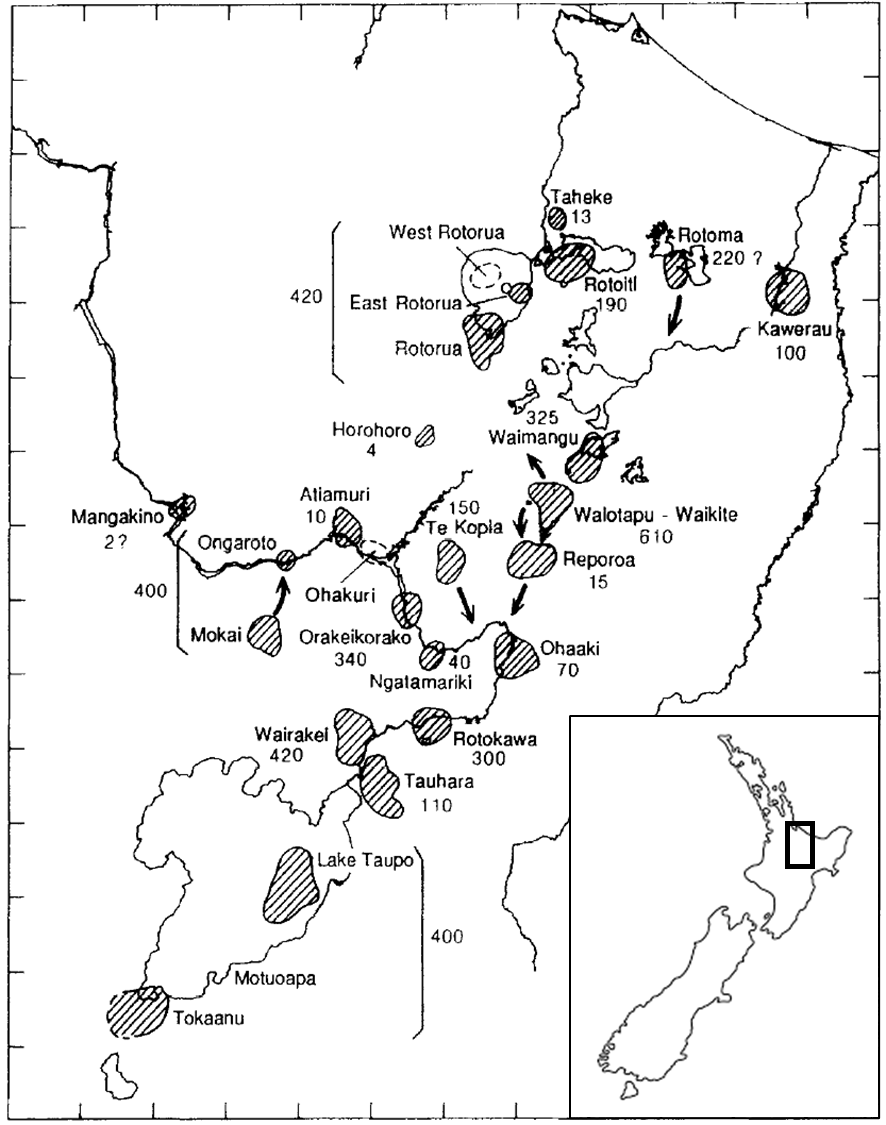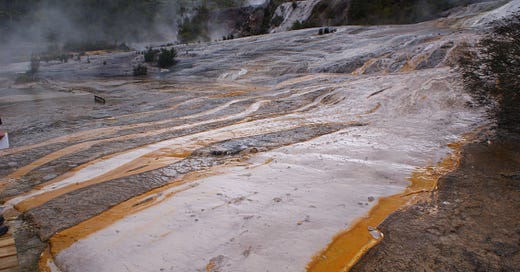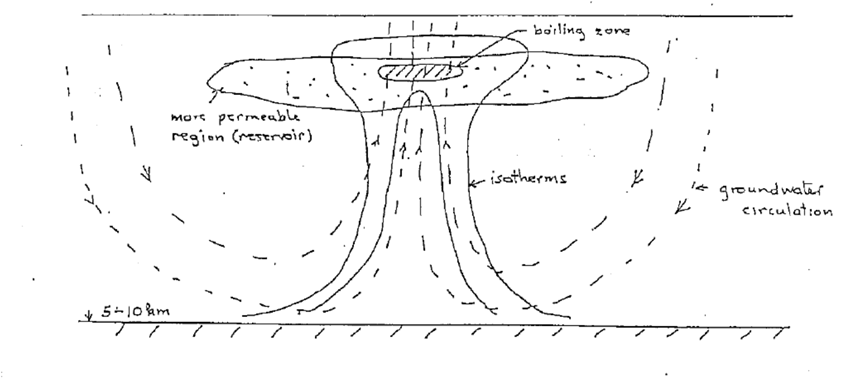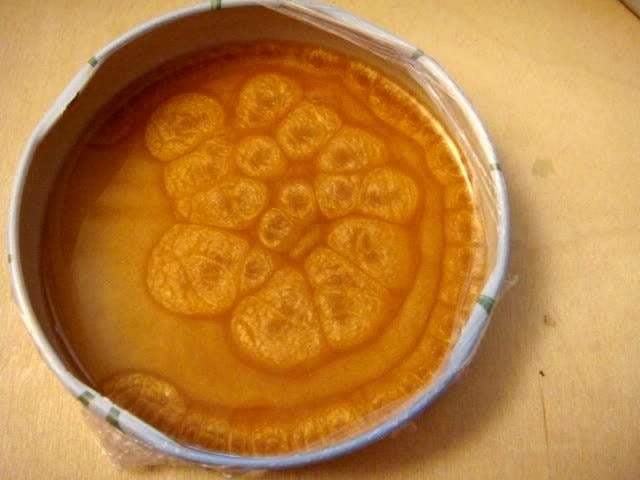Geothermal systems are giant radiators
A good way to understand a geothermal system is to follow the rainwater as it cycles through many kilometers of rock.
New Zealand gets about 20% of its electricity from geothermal. On visits to Rotorua or Taupō, you might have seen billowing plumes of steam or bubbling hot pools. But, much like an iceberg, most of what happens in a geothermal system is below the surface and out of sight. This post is a bit of an explainer to help you understand how geothermal systems work and where future geothermal technology might go.
Rainwater sinks deep into the Earth
Some time, a few thousand years ago, a storm or brief rain shower dropped some freshwater onto the faulted, forested landscape of New Zealand’s central North Island. Most of it evaporated back up into the sky, or ended up in a stream heading for the ocean, or was intercepted by a tree’s roots. But a small fraction of that water started percolating downward into the Earth.
Water will quite happily penetrate and pass through the sparse cracks and gaps in rock, buts it’s slow going. For the types of rocks relevant to geothermal - ash and lava from ancient volcanic eruptions (rhyolites) or more ancient, cooked seafloor (greywacke) - a drop of water would be lucky to move a few millimeters a day. But geology is patient and ultimately that rainwater is sinking into the earth at about a kilometer every six centuries (or a mile per millennia).
Conditions change as the water sinks. First, both its pressure and temperature steadily increase. Second, the cracks for water to flow through get narrower and less frequent. The ease with which water finds a path through is called the rock’s permeability and it tends to decrease the deeper you get. So the water has to stop sinking at some point.
The deepest that water gets to in NZ’s geothermal region is probably around 6 to 8 km. This is a bit of a guess based on, amongst other things, the depth that earthquakes stop happening. The reason that water stops (because permeability is too low) and then turns back around has to do with magma.
Water is heated and starts to rise
Magma comes in a lot of forms but the type that’s important for geothermal tends to exist as isolated pockets of slightly molten rock. These might sit between 5 and 10 km depth and, at more than 800°C, they’re much hotter than the surrounding non-magma rock. From time to time, new magma bodies come rising up from much deeper in the Earth. Some of these make it all the way to the surface to cause a volcanic eruption, but even more of it just stalls out for whatever reason.
These foreign bodies of magma disturb their surroundings, heating up the rock and water around them. This has three important effects.
When rock gets hot enough, it gets soft or ductile. Depending on the rock, this can start to happen around 350°C. Ultrahot rock, like honey warmed in the microwave, has a hard time keeping open cracks and gaps for water to flow through. That is, its permeability becomes very low. This means that sinking rainwater hits a bit of a wall and can’t get any deeper1.
When water heats up, it gets less dense. At 350°C, water’s density is 30% less than the cold surface water pressing down around it2. This makes the hot water buoyant and so it starts to rise.
Lastly, a little bit of water leaks out from the magma bodies and mixes in with the rainwater. It’s probably only 10% but you can see it in the isotopic chemistry of geothermal waters.
So, after a few thousand years of sinking, the rainwater is turned around and starts rising, now with some magmatic water mixed in. It’s also moving ten to a hundred times faster than before and will complete the return journey in a few hundred years or less. This suggests a problem - if the water sinks slowly but rises quickly, how do you match the velocities so as not to ‘run out’ of water at the bottom of the geothermal system?
The missing part has to do with geometry3. Basically, water is sinking through a much larger area of rock than it’s rising. You can think of the geothermal system like an upturned umbrella - it catches a lot of downwelling water across a really wide area and then focuses it into a much narrower upwelling region in its centre (the umbrella handle). So, if you’ve got water sinking slowly at 4 mm/year across 100 km2, that can be balanced by a much faster upflow of 40 mm/year over 10 km2. This circulation pattern is called Rayleigh-Bénard convection and it’s the same pattern that appears when you heat water in a wide flat pan on the stove.
What’s interesting is that theory and experiments show that we should expect more than one of these upwelling regions with each one being a separate geothermal system. Which helps explain how NZ has so many. For circulation that is open at the top (rainfall can enter, geothermal water can leave) but closed at the bottom (ductile rock, near-zero permeability), theory tells us to expect geothermal systems that are spaced horizontally at twice the distance the water flows to vertically. So, if water is sinking to about 6 km depth, we’d expect geothermal fields every 12 km or so and that’s roughly what you see in the central North Island.

Back to the surface
Left alone, rising geothermal water will find its way back to the surface. Here, it might enter the plumbing system of a geyser, to be rapidly ejected during an eruption. Or, as it shallows and the pressure reduces, the water can rapidly boil with the steam discharging as a roaring fumarole. Or the water might mix with cooler surface waters to create a bubbling mudpool or a colourful thermal pool. Some alluring options.
But, much of the geothermal water doesn’t make it back to the surface — or at least not immediately. Instead, it gets temporarily detained in reservoirs a few hundred meters below ground. These rock volumes have lots of gaps for the hot water to reside and an impermeable roof of clay over top. Unable to pass through the clay, the geothermal water is deflected sideways, which creates a kind of mushroom-shaped top of the geothermal system.
The clay roof of the geothermal reservoir is formed naturally by the geothermal water heating up the surrounding rock. The reservoir itself is a prime target for geothermal power stations because all that hot water has naturally accumulated at reasonably shallow depths. A second advantage of the clay is that it has an extremely visible electromagnetic signature. Scientists have used this to locate geothermal fields using the same tech as airport metal detectors.

Geothermal systems are giant radiators
Your car’s radiator functions by stripping heat from the engine and dumping it to the atmosphere. Its ultimate goal is to prevent the engine from overheating. Radiators achieve this by circulating a coolant fluid through a series of pipes and passages with a pump forcing the circulation. The coolant gets heated as it nears the engine and then cools down as it passes through the radiator’s fins.
We can think of a geothermal system like a radiator:
The equivalent of a circulating coolant is rainwater. Rather than cycling continuously, like in a car, it enters once at the surface and then leaves after its long journey to magma and back again is complete. Regular rainfall keeps the radiator topped up.
Instead of pipes and hoses running around the engine, rainwater circulates through the cracks and gaps in rock that comprise its permeability.
Rather than requiring a pump to force circulation, rainwater sinks and rises naturally, driven by buoyancy forces that arise temperature-driven changes in density.
And the ‘engine’ that is being cooled are the intruded pockets of magma at 5 to 10 km depth. Although each magma body is not continuously generating new heat (like an engine does), the arrival of new stalling magma bodies does provide a sort-of continuing, if irregular, supply of heat to the geothermal engine.
Why do I think the radiator analogy is useful? Well, radiators are well understood mechanisms. We know how they’re built, how they can be improved, and how they fail. Does that suggest anything interesting about geothermal systems?
Broken radiators, CO2 geothermal, and fracking
Probably my favourite what-if scenario is the broken-radiator concept. What would happen in the hypothetical situation that we just switched off all that circulating rainwater? Well it would be reasonable to expect some temperature increase at depths in and around where the magma is stalling. Temperatures would probably increase at shallower depths too as theory tells us that downwelling rainwater is likely to be cooling the rock it sinks through. Would this hotter rock affect how fast the Earth is tectonically spreading in the region (called rifting)? Would volcanic eruptions become more or less frequent? Fun to speculate on…
What about if we made the geothermal radiator more efficient by replacing the coolant with something other than rainwater? Some decades ago, Donald Brown, a scientist at Los Alamos National Laboratory, suggested creating geothermal systems that used liquid carbon dioxide as the circulating fluid. Besides keeping some CO2 underground (and out of the atmosphere), it has some nice properties as a coolant: a lower viscosity than water, which promotes easier circulation through the rock (although its heat-carrying capacity is less). A thermosiphon effect that can reduce the need for pumps in geothermal wells. Some folk are serious about getting this CO2-plume concept off the ground, not least because it ties in with ambitions to capture and sequester vast amounts of atmospheric CO2.
Lastly, what if we unleashed the radiator by greatly expanding the number and size of pipes for coolant to flow through while upgrading its pump to push coolant through more rapidly? This is more or less the idea behind an Enhanced Geothermal System, which uses (1) hydraulic fracturing to upgrade the permeability of rock, and (2) large pumps to force water between injection and production wells. Although the idea has been in various stages of development for 50 years, Fervo Energy, a US company adapting Oil & Gas technology to geothermal, seems to have cracked commercial viability.
In fact, there are lots of exciting and frontier geothermal technologies out there right now.
Supercritical geothermal that drills right to the magma interface. Higher temperatures = more energy.
Extracting the lithium that is dissolved in geothermal waters in California. An extra revenue stream?
Sucking CO2 out of the atmosphere and storing through reactions with geothermal rocks in Iceland.
Repurposing oil & gas fields as ‘batteries’ that store geothermal heat. A new life for otherwise stranded assets?
The future of geothermal looks to be heading in some strange directions. I’m aiming to write about some of these concepts in the coming months. But a bit of understanding about ordinary geothermal systems first can provide some clues about what’s likely to succeed in the future.
It’s also why earthquakes stop happening. Earthquakes are essentially shear failure in brittle rock. Weak, ductile rock can’t build up enough strain to release during an earthquake and so the rock is no longer seismogenic.
Water at this temperature would boil to steam if it were at the surface. However, at 6 km depth, the pressure is so high that it stays a liquid.
If you want to get into the maths, my favourite paper on this is by Graham Weir (2009) “A Mathematical Model of Rainfall-Controlled Geothermal Fields”, Transport in Porous Media 77.







David,
I was an undergrad at UC and had the pleasure of taking a few courses with you.
I always found you to be an excellent teacher and have thoroughly enjoyed coming across any articles, posts, or writings from you since having finished uni.
Glad to see you have set this up and all the best!
Sam
Thanks for the explainer! Helps me understand things better.